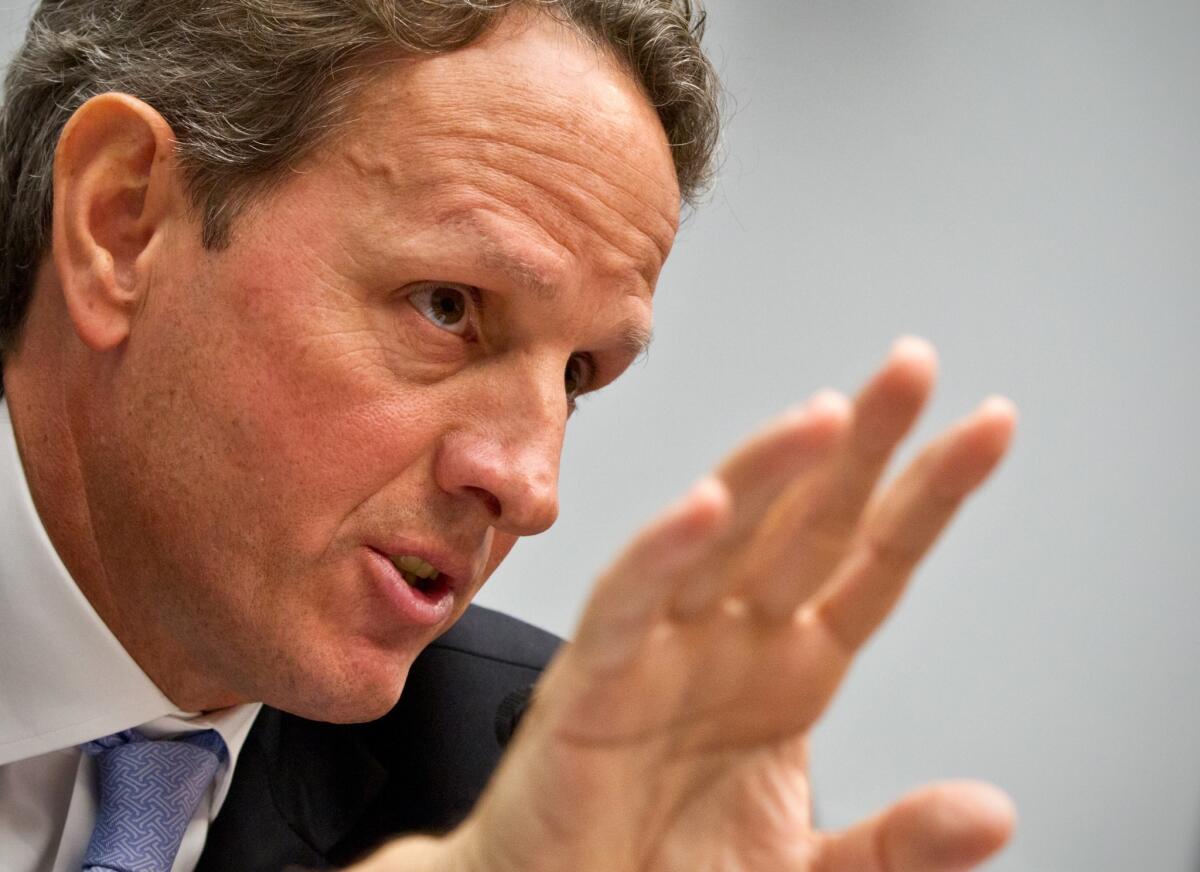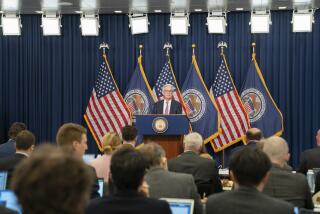Review: Timothy Geithner unapologetic in memoir of the financial crisis

- Share via
Former Treasury Secretary Timothy F. Geithner never seemed to fit in the nation’s capital. And he knew it.
He begins his memoir, “Stress Test: Reflections on Financial Crises,” by admitting that he was “an unorthodox choice” for one of the most crucial Cabinet posts – a position of even more importance when President Obama tapped him in late 2008 amid the worst panic since the Great Depression.
“I wasn’t a banker, an economist, a politician, or even a Democrat,” Geithner writes. He recalls one lawmaker joking that his youthful appearance meant “I looked like I was at my own bar mitzvah.”
But Geithner had a major strength on his résumé. As president of the Federal Reserve Bank of New York, he had been a key architect, along with Fed Chairman Ben S. Bernanke and Treasury Secretary Henry Paulson, of the government’s response to the cascade of calamities in 2008 that threatened to destroy the global financial system.
Those actions included the rescue of insurance giant American International Group, housing finance firms Fannie Mae and Freddie Mac and the most unpopular of all the crisis interventions – the creation of the Troubled Asset Relief Program, the $700-billion bailout fund that pumped piles of taxpayer money into some of Wall Street’s biggest banks.
Paulson left along with President George W. Bush in early 2009. Bernanke seemed to largely float above the fray. That left Geithner as the boyish face of the controversial bailouts.
He became the staunchest defender of the government’s unprecedented actions: unapologetic and eager to boast that the Treasury ultimately recovered more TARP money than was spent. Geithner has never wavered in his assertion that the bailouts and other steps were as necessary as they were unpalatable, even as he was portrayed as being much more concerned with helping Wall Street than Main Street.
He spends much of the engaging but ultimately unsurprising 580-page “Stress Test” amplifying his case.
Geithner does an admirable job of explaining the origins and complexities of the crisis for the average person. But there’s enough detail and retrospective lessons-learned to make it valuable for students of financial history.
The book’s title is a reference to the program Geithner designed in early 2009 to determine if the nation’s large banks could survive the worsening economic conditions or might need more bailouts – and ultimately perhaps be nationalized. The tests led the banks to raise more capital and pay back their bailouts.
But “Stress Test” also refers to his baptism by fire responding to the 2008 crisis and then dealing with overwhelming criticism and derision of his early performance as Treasury secretary.
“Mr. Secretary, when I see you on TV, I get the feeling you’re not telling us everything,” Barbra Streisand told him at a White House state dinner.
Finally, the whole experience was a broader stress test for the American political system – one Geithner argues it managed to pass despite all its dysfunction. “There are lessons for the world in our mistakes as well as our successes,” Geithner writes as he tries to provide a road map for fighting future crises. “My hope is that they won’t have to be rediscovered in the fires of the next crisis.”
The book’s depiction of the chaos of the fall of 2008 is fast-paced and colorful. Geithner is known for his temper and use of expletives, and the book is spiced with more than a dozen uses of the F-word. He’s at his most interesting – and controversial – in his vigorous running justification for all the rescue actions he and other federal officials took and his argument that saving the financial system was more important than punishing “the Wall Street gamblers.”
“In a brutal financial crisis like ours, actions that seem reasonable – letting banks fail, forcing their creditors to absorb losses, balancing government budgets, avoiding moral hazard – only make the crisis worse,” he writes. “And the actions necessary to ease the crisis seem inexplicable and unfair.”
To make it more explicable, Geithner sprinkles the book with a handful of charts as well as disdain for his critics and their push for what he frequently refers to as “Old Testament justice” that would have caused more pain for the nation.
Geithner describes himself as a “reluctant warrior” – he said he tried to talk Obama out of nominating him – and is frequently self-deprecating, noting he “lacked gray-haired gravitas” and was an uninspiring public speaker who looked “shifty.”
He also has plenty bad to say about “the soul-crushing pathologies of Washington.” In the first days of the Obama administration, Geithner recalls a White House aide handing him some brief comments critical of Wall Street bonuses that she wanted him to deliver during an appearance in the Oval Office with Obama.
“I’m not very convincing as an angry populist, and I thought the artifice would look ridiculous,” Geithner wrote. “ ‘I’m not doing this,’ I said. Instead, I sat uncomfortably next to the President while he expressed outrage.”
He fashions “Stress Test” as an insider’s story with an outsider’s perspective, and he goes out of his way to tell how miserable he was during his time in Washington. Geithner admits he was more comfortable as “a backstage guy,” a role he played in battling the Asian financial crisis as a Treasury official in the late 1990s and as the junior partner in the troika with Paulson and Bernanke in the financial firefight in the fall of 2008.
Several times, he points out the misconception that he had worked on Wall Street (though he stoked that after stepping down from Treasury last year when he took a job with a leading New York private equity firm). He recalls bristling when then Securities and Exchange Commission Chairman Chris Cox thanked some of Wall Street’s top chief executives for “their patriotic service” in trying to jointly find a way to save Lehman Bros., whose bankruptcy triggered the crisis.
“I was in too dark a mood to congratulate bankers for trying to protect themselves from a life-threatening storm they had helped cause,” Geithner writes.
Yet “Stress Test” goes beyond other crisis books, such as Paulson’s “On the Brink,” in covering the entirety of the government response – 2007 through 2012 -- from the ultimate insider’s perspective.
Geithner also goes further in defiantly defending the unpopular bailouts that are a major part of his legacy.
“I’m proud of what we’ve done,” he told Obama shortly before the 2008 election when the candidate was considering tapping Geithner as Treasury secretary, even though the move would carry the stigma of the bailouts into a new administration.
Geithner writes, “I’m not going to renounce it or criticize it.”
Stress Test
Reflections on Financial Crises
Timothy F. Geithner
Crown: 580 pp., $35
More to Read
Sign up for our Book Club newsletter
Get the latest news, events and more from the Los Angeles Times Book Club, and help us get L.A. reading and talking.
You may occasionally receive promotional content from the Los Angeles Times.








